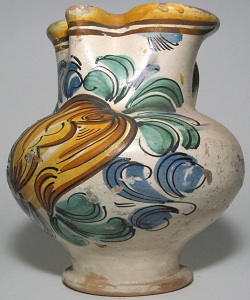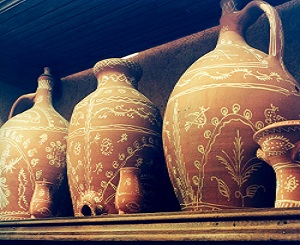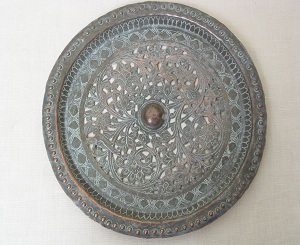
Ceramic, glass and copper items

The Skyrian house is decorated with ceramic, glass and copper objects, from various parts of the world, which are divided in categories. Some are purely decorative, while others have functional use.
The Skyrian house is decorated with ceramic, glass and copper objects, from various parts of the world, which are divided in categories. Some are purely decorative, while others have functional use.
Ceramics
Of the ceramics, first come the so-called Rhodian, the old ceramics of Nicea (Iznik)
Among the best crockery of the "Aloni" are the large "blue plates". These are the famous Dutch Delft plates, produced between 1600-1800. They are copies of Chinese plates and their value is immense.
Smaller in size, but of great value because of their rarity, are the Chinese and Korean plates from the 18th century, made of porcelain and intended for export.
Then come the "lainissa", which are platters and plates with vivid brown and yellow colors, mainly of Spanish and Italian origin. The blue dishes of the same origin, with the various presentations of ships and people, are rated second to the "lainissa".
After the blue dishes, come the "agalipa" plates, which have a white background, a green border and a presentation of a palm tree in the center. Lastly, there are the yellow plates which are regarded as somewhat inferior. They are called "krokos" (egg-yolk) because of their colour.
The second category of ceramics which are equally valuable, are the various vases with various names, uses and shapes. Numerically, the largest group consists of the "lainia" (pitchers), which were used as wine jugs (San Vino). Many of these "San Vino" pitchers are decorated with the double-headed eagle (the symbol of Byzantium) and have folk poetry written in Greek on them, praising wine-drinking or warning drinkers of the evils of too much wine, however they are not Greek. They were produced in Italy on orders placed by Greek merchants or were adapted by the makers themselves to suit the Greek market for which they were intended. Aside from the Italian, there are also the Spanish "lainia" dating from 1700-1800.

Other vases are the so-called "bournies", which have an unusual shape (Albarello) and where used by the Skyrian women for preserving jams. Originaly they were used for storing medicines in chemists shops.
In addition to these "typical" and common vases, there are other kinds of ceramic objects, such as dolls, mostly of women, salt cellars, ink pots in the form of statuettes, representing dogs, horses and other animals. They originate from the same workshops and countries.
Some of the upper class houses had ceramics from North Africa, known as "Kopta". They are mainly covered vases of various sizes. The dark yellow color predominates and their decorative motifs are painted either in green or brown. The Skyrian women call them "Barbaressikes vavathes" and they are considered inferior to the "lainisia".
The dishes with the roses are another category, which is also considered "good". These plates are delicate, with a white background and red flowers in the middle, which look like roses.
Kastriana
Apart from the above mentioned wares, which are the most valuable and decorate the main areas of the house and the areas that can be seen by visitors, there are also ceramics of lesser value, which serve both utilitarian and decorative purposes. In this category we find the ceramics of Canakkale, known in Skyros as "Kastriana". They can be found in the houses of the island in the form of oval dishes, covered bowls, "prozmera" (covered bowls where they kept yeast for their bread), and small jars called "vytnaria". Their predominant colours are brown and blue. You would never see them in the "good part" of the house, only in the "apokrevate", where they hung for both practical and decorative use.
There are also several Delftware items of the late 18th century, which were produced in England in the Delft type of earthenware.

Original Skyrian ceramics
The traditional Skyrian ceramics were made of red clay and were decorated with skyrian designs, in white colour. Their use was mainly practical, for everyday use:
-Urns,
-Jugs,
-Pitchers,
-Pots,
-Covered pots,
-"Prozmera",
-Censers,
-Flowerpots,
-"Favatotsoukala" (pots specially used for making vafa), -Jars, etc.
These were also made in miniatures, as toys for children.
Glassware
Among the clearly decorative items, are various china pieces. Of these, first come the so-called "farfouria", a term used to describe the quality and the material with which a stet of various objects, such as vases, cups (mastrapades), perfume and ouzo bottles, etc, were made of. Most of these items are of excellent workmanship, and have on them painted in gold the crescent moon emblem of Turkey.
The quantity, quality and the crescent moon stamp, are indicative of their origin. They are loot from ships that had been pirated on their way from European countries to Constantinople, where they were intended to decorate wealthy Turks houses, or even the Sultan's palace. We do not know when these ships were pirated, nor do we have any other details.
These items were usually specially ordered by the Sultan and produced in Bohemia, Venice and Spain. They are distinguishable by the generous use of gold in their decoration. It is possible that these items might be the so-called "Beykos" china, that is, objects produced in Turkey by Bohemian craftsmen, invited by the Sultan in the 1800s to the region of Beykos in order to produce these fine china ware locally.
Of lesser value, but in any case belonging to the same category, are the glassware objects known as "liapika".
They are named "liapika" because the pirates, who brought them and sold them to the inhabitants of Skyros, were called "Lipaides" by the Skyrians. They are made of glass or carved crystal, with gold embellishments, and have various uses (bottles, hookahs, vases, drinking glasses, etc).
Copper decorative items
 Copperware is the second largest category of decorative objects found in the Skyrian house.
Copperware is the second largest category of decorative objects found in the Skyrian house.
Of these, first come the richly decorated "sinia", large copper plates decorated with various motifs, such as monasteries, trees, geometric patterns, pentagrams, etc. most of the "sinia" date from the 18th century and, from their decoration and inscriptions found on a lot of them, we can see that their origin and their producers are Greek and Arab.
The "sinia" are hung on walls and their main purpose is decorative. The families of the Great Strata (the area where the upper class lived), who were the exclusive owners of these plates in older times, often used them on folding tripods as tables. The wealthier families used the smaller "sinia" as trays to serve important visitors, and also in order to serve "koliva" (boiled wheat served in memorial services).
Other copper decorations included large baking trays, smaller baking tins, and the richly embellished perforated covers which matched the wash basins.
In contrast to the "sinia", which were decorative, the "tavades" (deep pans) were used for the preparation of pies, especially "trahanopita", a pie made at carnival time. Only families which did not belong to the Great Strata used them for the decoration of the best part of their house.
Other copper objects, which were placed on shelves or tables and not hung on walls, are the "legenobrika" (pitcher and basin set) and oil lamps.









